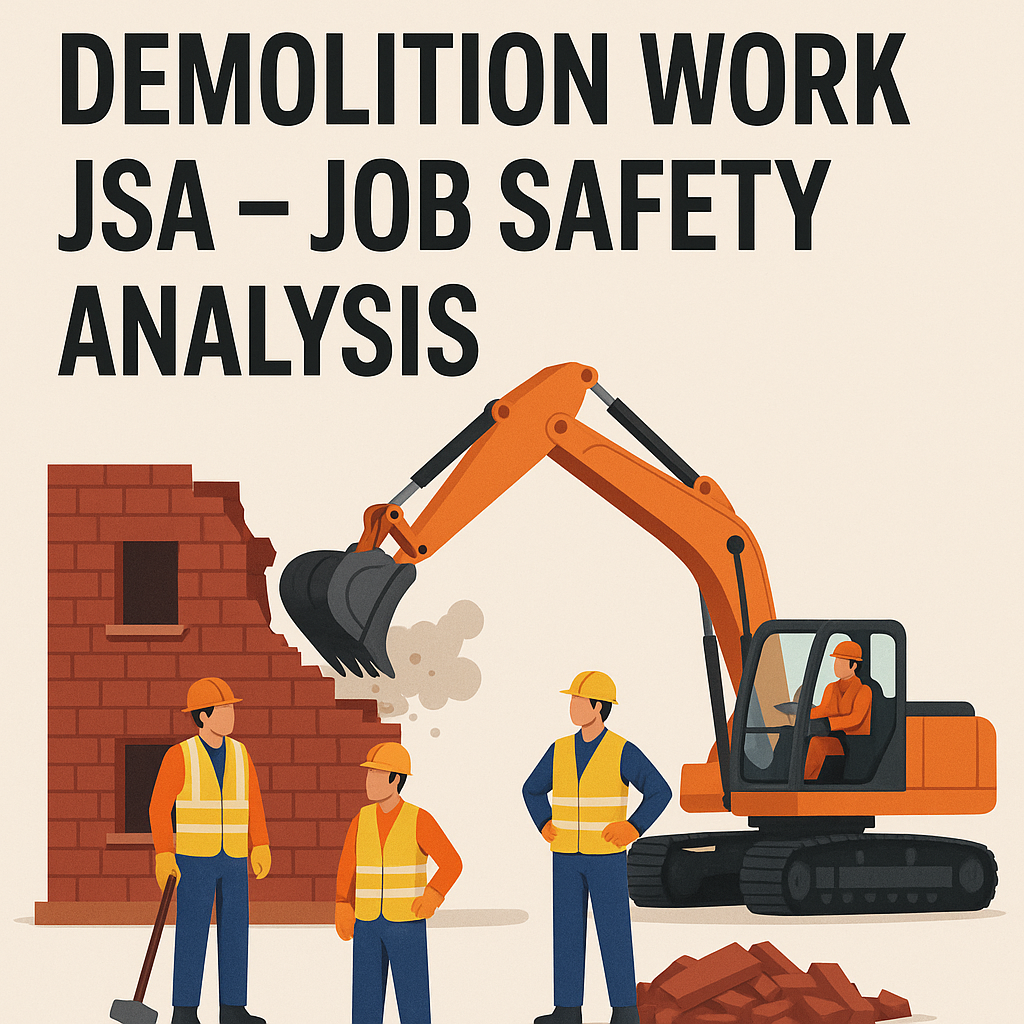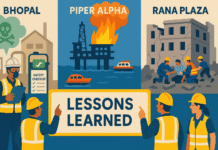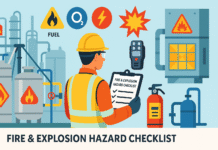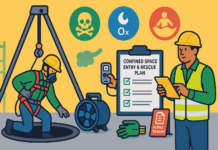
Demolition Work JSA – Job Safety Analysis
1. Introduction
Demolition work involves dismantling, wrecking, or destroying structures and buildings. It may include manual demolition, mechanical demolition using excavators or cranes, controlled blasting, or a combination of these methods.
Demolition is considered one of the most hazardous construction activities due to risks such as structural collapse, falling debris, dust exposure, noise, vibration, heavy equipment operation, and presence of hazardous materials (asbestos, lead, silica, etc.).
A Job Safety Analysis (JSA) helps ensure hazards are identified, risk levels are assessed, and appropriate control measures are implemented before starting demolition.
2. Purpose of This JSA
The objectives are to:
- Identify and control hazards related to demolition activities.
- Prevent accidents involving collapse, falling debris, and equipment hazards.
- Ensure compliance with OSHA, NFPA, and local demolition safety codes.
- Protect workers, nearby communities, and the environment.
- Establish emergency response plans for accidents or structural failures.
3. Applicable Standards & References
- OSHA 29 CFR 1926 Subpart T – Demolition
- NFPA 241 – Safeguarding Construction, Alteration, and Demolition Operations
- IS 4130 – Safety Code for Demolition of Buildings (India)
- BS 6187: Code of Practice for Demolition
- ISO 45001 – Occupational Health and Safety Management Systems
- Company-specific Demolition Procedures
4. Scope of Work
This JSA applies to demolition activities including:
- Partial or full building demolition.
- Structural dismantling (walls, beams, slabs, foundations).
- Use of hand tools, power tools, or heavy machinery for demolition.
- Debris handling, collection, and disposal.
- Site cleanup and waste management.
5. Step-by-Step JSA Process
Step 1: Job Breakdown
- Pre-job planning and risk assessment.
- Securing work permits and isolating utilities (electricity, gas, water).
- Installing barricades, warning signage, and exclusion zones.
- Mobilizing equipment and PPE.
- Structural weakening or soft stripping (removing non-structural items).
- Controlled demolition (manual, mechanical, or explosive).
- Removal and disposal of debris.
- Site inspection and clearance.
Step 2: Hazard Identification
Demolition hazards include:
- Structural collapse without warning.
- Falling debris striking workers.
- Trips, slips, and falls from uneven ground or rubble.
- Dust exposure leading to respiratory diseases (silica, asbestos, lead).
- Noise and vibration affecting hearing and equipment stability.
- Fire and explosion risks from flammable residues.
- Heavy machinery hazards (struck-by, caught-in).
- Electrical shocks from live wires not isolated.
Step 3: Risk Assessment Table
| Task | Hazard | Consequence | Risk Rating | Control Measures |
|---|---|---|---|---|
| Site preparation | Unsecured utilities | Explosion, electrocution | High | Isolate utilities |
| Barricading | Unauthorized access | Fatal injury | High | Fencing, signage |
| Structural weakening | Collapse | Multiple fatalities | High | Engineer-approved plan |
| Manual demolition | Falling debris | Head injury | High | Helmets, exclusion zones |
| Mechanical demolition | Struck by equipment | Fatal injury | High | Spotters, machine guards |
| Debris removal | Cuts, dust exposure | Injury, lung disease | Medium | PPE, dust suppression |
| Waste disposal | Handling heavy waste | Musculoskeletal injury | Medium | Mechanical lifting aids |
6. Control Measures
A. Engineering Controls
- Use designed demolition sequence approved by structural engineers.
- Install temporary supports, bracing, or scaffolds to prevent premature collapse.
- Apply dust suppression systems (water spraying, misting).
- Ensure proper guarding of demolition machinery.
B. Administrative Controls
- Implement a Permit-to-Work System for demolition.
- Only trained and competent workers allowed in demolition zones.
- Assign a demolition supervisor and spotters to guide equipment.
- Conduct toolbox talks daily on hazards.
- Restrict access with barriers, fencing, and signage.
C. Personal Protective Equipment (PPE)
- Hard hat with chin strap.
- Safety goggles or face shield.
- Hearing protection (ear muffs/plugs).
- Respiratory protection (N95/PAPR for silica/asbestos).
- High-visibility vest.
- Safety boots with steel toe.
- Cut-resistant gloves.
7. Roles & Responsibilities
- Site Manager: Approves demolition plan and resources.
- Structural Engineer: Designs safe demolition sequence.
- Supervisor: Oversees daily activities and compliance.
- Machine Operators: Operate excavators, cranes, and breakers safely.
- Fire Watcher: Monitors hot work if cutting torches used.
- Safety Officer: Conducts site inspections and risk monitoring.
8. Emergency Preparedness
- Emergency evacuation plan in case of collapse.
- Fire extinguishers placed strategically.
- First aid station onsite with trained responders.
- Ambulance service available nearby.
- Communication system (radios, alarms) for quick alerts.
- Rescue team standby during high-risk demolition (e.g., confined structures).
9. Best Practices for Demolition Safety
- Always start demolition from top to bottom and outside to inside.
- Maintain safe distance between demolition equipment and structures.
- Remove hazardous materials (asbestos, chemicals) before demolition begins.
- Never overload debris handling equipment.
- Inspect machinery daily before use.
- Monitor vibration levels near neighboring structures.
- Maintain 24/7 site security to prevent unauthorized access.
10. Sample JSA Form – Demolition Work
Job Title: Demolition Work
Location: ________________________
Date: ________________________
Supervisor: ________________________
| Task Step | Hazard | Control Measure | PPE Required | Responsible Person |
|---|---|---|---|---|
| Site preparation | Unsecured utilities | Isolate gas, power, water | Helmet, vest | Supervisor |
| Barricading | Unauthorized entry | Install fencing, signage | Vest | Safety officer |
| Demolition | Collapse, debris | Engineer plan, exclusion zone | Helmet, harness | Crew |
| Machinery use | Struck by machine | Spotter, barricade | Helmet, boots | Operator |
| Debris removal | Dust, sharp objects | Dust suppression, gloves | Gloves, respirator | Crew |
11. Conclusion
Demolition is high-risk by nature, but with proper planning, controlled execution, and effective safety measures, the risks can be minimized. A comprehensive JSA ensures that all workers understand the hazards, follow safe procedures, and remain prepared for emergencies.
✅ Final Safety Reminder:
“Demolition work can bring structures down — but with the right precautions, it should never bring lives down.”
Hot Work JSA – Job Safety Analysis
Rebar Cutting and Bending JSA – Job Safety Analysis
Concrete Pouring and Formwork JSA – Job Safety Analysis
Excavation and Trenching Safety JSA – Job Safety Analysis
Scaffold Erection and Dismantling JSA – Job Safety Analysis
























